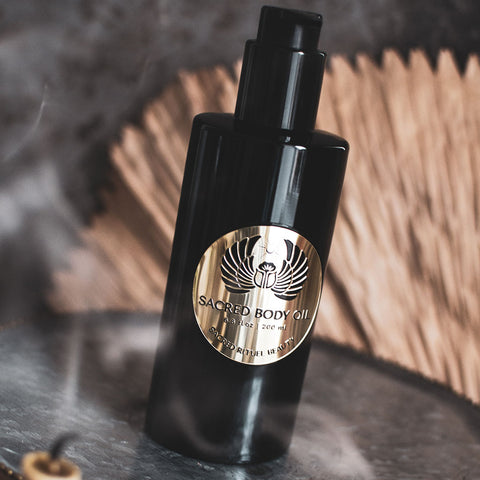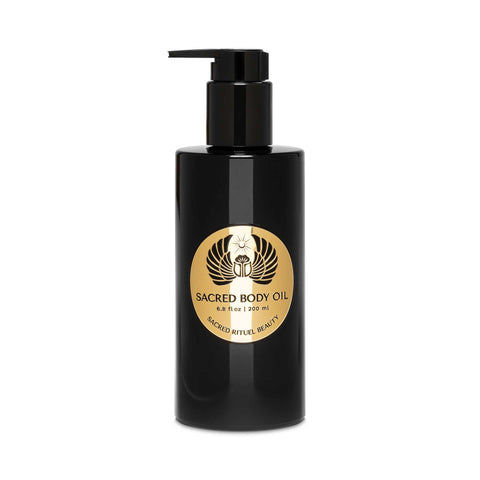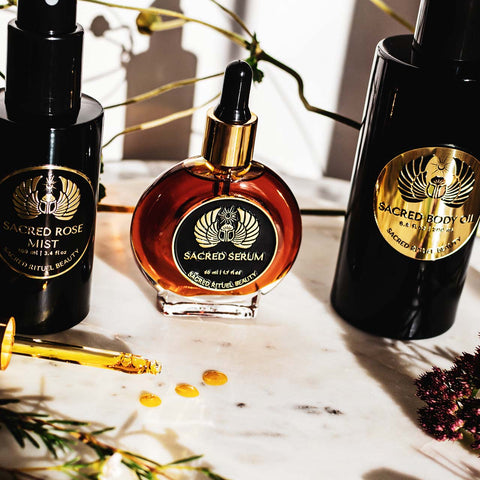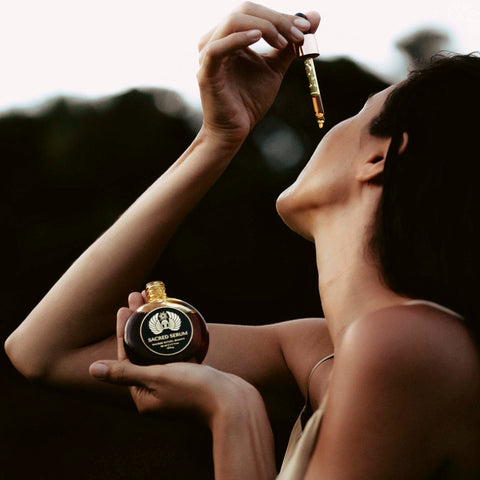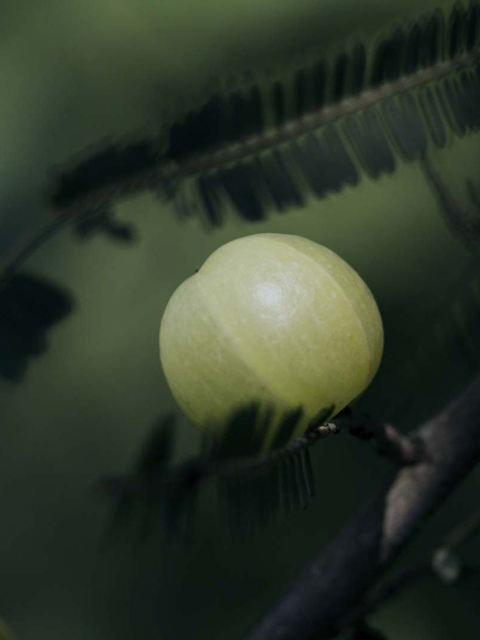
Ingredient Page: Amla Fruit Oil
They say sometimes, the tiniest things can make such a big difference, and Amla is one of the fruits that proves just that. Small, tart, and cheerfully yellow-green, these berries pack quite a lot, including plenty of nutrients to help your body and skin function well.
So, let’s explore everything you need to know about Amla’s fruit oil, including its benefits, extraction process, shelf life, and more!
Are you interested in using nutrient-packed oils like Amla Fruit Oil for your skincare needs? Experience the enchanting healing power of nature’s most revered plants with our potent Sacred Serum. Discover today, risk-free, with a 30-day satisfaction guarantee.
|
Type: Amla Fruit Oil is derived from Phyllanthus emblica, a flowering tree native to the sun-kissed regions of India, China, Iran, and Pakistan. History: Amla has been traditionally used to treat digestive issues¹ and eventually used to treat scalp conditions like dandruff and promote healthy hair growth.² Benefits: Known as a super berry with antiseptic, anti-inflammatory, and hair-enhancing properties when used topically. A Sacred Secret? This dark, yellow-green oil is pretty versatile and can be used as an overnight hair mask or styling product and an anti-inflammatory or moisturizing skincare product. |
Background: Amla Seed Oil
Amla, or Indian gooseberry oil, is derived from Phyllanthus emblica, a tree native to the sun-kissed regions of India, China, Iran, and Pakistan. It has long been used in Ayurvedic medicine for its high Vitamin C and antioxidant levels, becoming a core ingredient in Chyavanaprasha,³ a traditional Indian bioactive health supplement in the form of a jam.
Traditionally, Amla was used both as dry and fresh fruit to treat dyspepsia and other digestive issues.¹ It was also believed to work as a rejuvenator, and its inner tree bark was often used in soups.
Thanks to its high tannin content, Amla is now a key ingredient in inks, shampoos, hair oils, and dyes. Its oil is known to stimulate hair growth and enhance hair's softness and shine,2 making it a popular component in many hair products today.

Benefits include:
- Reduces inflammation and irritation
- Promotes healthy hair growth and reduces hair loss
- Eases digestive discomfort
Sacred Serum & Amla Fruit Oil
Sacred Serum adapts to your skin type due to a balanced formula of botanical super-food flowers, and plant and seed oils. Working synergistically with the 26 other organic ingredients in Sacred Serum, Amla seed oil goes deep into the skin to feed, protect, and beautify.
Sacred Serum Benefits:
- Deeply moisturizes for an instant visible glow;
- Reduces inflammation and promotes cell regeneration for a visibly youthful glow;
- Amplified by 777 mg USA-certified organic full-spectrum Hemp extract;
- Has a light texture that quickly absorbs into the skin for an instant smoothing and soothing effect;
- Protects you from environmental damage using powerful antioxidants, fatty acids, and vitamins A, B, C, D, E;
- Results in unbelievably smoother, brighter skin, visibly transformed in a few days.
Why Choose Organic, Cold-Pressed Amla Fruit Oil?
Embracing organic means indulging in nutrient-dense elements, untouched by harmful chemicals and pesticides. The secret to glowing skin lies in an abundance of vitamins and nutrients, hence Sacred Rituel’s commitment to the purest organic ingredients.
-
Organic (Biodynamic) Label: Refers to how ingredients are grown and harvested.
-
Cold-Pressed Label: Refers to how ingredients are processed from a plant or seed to oil. When oils are cold-pressed, they are extracted from their source using mechanical methods rather than heat or solvents.
With cold-pressed oils, there is very little processing, which allows it to retain important nutrients responsible for healing. Ultimately, cold pressing delivers a potent product that's highly effective AND safe because there aren't any additives. It’s a win/win for your skin!
All Sacred Rituel ingredients are made without:
- Artificial Colors & Dyes
-
Preservatives, Parabens, Phthalates
Preservatives: May be used in cosmetics to prevent the growth of harmful bacteria and mold. Parabens and formaldehyde-releasing preservatives are commonly used preservatives in cosmetic and personal care products.
Parabens: Are preservatives used in a wide variety of personal care products and foods to prevent the growth of microbes. These endocrine-disrupting chemicals can be absorbed through the skin, blood, and digestive system.[1]
Phthalates: Pronounced THAL-ates, these chemicals, which are linked to endocrine disruption, developmental and reproductive toxicity, and cancer, have been banned from cosmetics in the European Union but still remain prevalent in U.S. products.
Methylisothiazolinone (MIT) & Methylchloroisothiazolinone (CMIT): They may be hard to pronounce, but they can be even harder on the body. These common preservatives are found in many liquid personal care products and have been linked to lung toxicity,[1] allergic reactions, and possible neurotoxicity.
- Synthetic Fragrance
- Fillers, Stabilizers, & Binders
- Nanomaterial & Nanoparticles
- Retinol & Retinol Compounds
Sacred Secrets: All Things Amla Fruit Oil
What is Amla Fruit Oil?
Amla Fruit Oil is a dark, yellow-green oil with a distinctive earthy aroma. It’s widely used in hair care products because of its nourishing and conditioning properties, as well as its abundant fatty acid, antioxidant, and vitamin content.
This oil is often famous for its anti-inflammatory and antiseptic properties,⁴ so you’ll see it as an ingredient in shampoos that treat scalp conditions like dandruff. You’ll also notice it’s promoted as a product that reduces hair loss and stimulates hair growth and it is a super star ingredient for the skin.
How is Amla Oil extracted?
To extract Amla Fruit Oil, dry and grind the fruit into powder. Mix this with a base oil such as coconut, sesame, or almond, and heat at a low temperature for several hours to extract the oil. Finally, filter and bottle the oil.
What are the benefits of Amla Oil?
Amla Fruit Oil offers benefits in different areas:
-
Hair Benefits: Amla Fruit Oil promotes hair growth and improves scalp health. It’s rich in vitamin C, which strengthens the hair follicles and stimulates hair growth. It can also reduce dandruff, scalp irritation, and hair breakage.²
-
Skin Benefits: Amla Fruit Oil is rich in antioxidants, which protect the skin from environmental damage. It can also reduce inflammation, redness, and the appearance of wrinkles.⁴
- Health Benefits: Amla Fruit Oil possesses anti-inflammatory properties, which can benefit those suffering from certain inflammatory diseases. It can also lower blood pressure and reduce the risk of heart disease,⁵ as well as improve digestion and reduce bloating.⁶
What are the uses of Amla Oil?
As you may have already noticed, Amla Fruit Oil is so versatile that you can use it in many different ways! A few examples of ways you can use amla oil include:
-
As a pre-shampoo treatment: You can use Amla Oil to revive and condition your hair and scalp by massaging them with the oil and leaving it on for at least 30 minutes before shampooing.
-
As an overnight hair mask: If you have time to let your hair soak, you can massage Amla Oil on your scalp and hair, wear a shower cap, and leave the oil overnight. This should allow your hair to absorb the oil’s nutrients before you rinse it in the morning.
-
As a styling product: Not a fan of soaking? You can use a few drops of Amla Oil to tame your hair and give it a glossy finish.
-
As a moisturizer: If you’re a fan of using oils, you’ll be delighted to know you can use Amla Oil as a moisturizing massage oil. Simply massage the oil on your skin, leave it for 30 minutes, and then rinse.
- As a remedy to acne: Remember how we mentioned Amla Oil is an anti-inflammatory? This means it can soothe acne by reducing inflammation and irritation. Just massage Amla Oil into the affected areas, leave it overnight and rinse the next day.
What is the recommended dosage of Amla Oil?
The dosage of Amla Oil varies based on your needs. For hair, use two to three drops, while the amount for skin depends on the coverage area. If you intend to consume Amla Oil, consult a healthcare professional for accurate dosage and potential side effects.
How to keep Amla Oil?
If you’re thinking of getting Amla Oil or already have one, here’s how you can store it:
- Find a cool, dark space to keep the Amla Oil in.
- Always ensure the oil container is tightly sealed so the oil doesn’t evaporate.
- Add a few drops of vitamin E if you want to extend its shelf life.
- Don’t mix the oil with other oils.
- Don’t use it for longer than a year.
Want to learn more about plant-keeping? Discover how you can grow a medicine garden, process your plants, and create remedies with our co-founder and product formulator Marysia’s herbal apothecary book!
Did you know? Herbalism is the practice of utilizing medicinal plants to support wellness and health. This study dates back to the Paleolithic age and predominantly practiced in Asia and Africa. Marysia Miernowska focuses on European folk herbalism which is an homage to her Polish lineage, finding regenerative ways to heal both people and the Earth.
Where can I buy Amla Oil?
You can find Amla Fruit Oil in health food stores, online retailers, and specialty stores. It can be purchased in liquid form, as a powder, or as a capsule. You can also purchase it in different sizes.
How long does Amla Oil take to grow hair?
Amla Oil is not a miracle product that will make your hair grow overnight! Regularly applying Amla Oil to your scalp and hair can reduce hair fall and encourage the growth of new strands, but this process can take several weeks or months to become noticeable.
Does Amla Oil need to be heated?
Amla Oil does not need to be heated before use. It’s typically used as a cold-pressed oil, which means it’s extracted from the fruit without the use of heat. The oil can be applied directly to the scalp and hair without heating.
Which oil is best to mix with Amla Oil?
Amla Oil can be mixed with other oils to create a more nourishing treatment. Coconut oil, olive oil, almond oil, and jojoba oil are good options to mix with amla oil because they offer additional benefits for hair and scalp health.
Is Amla Oil non-greasy?
Amla Fruit Oil is non-greasy and does not leave a sticky residue.
What are the side effects of Amla on hair?
Amla Oil is generally safe to use on the hair and scalp, but some individuals may experience scalp irritation or an allergic reaction. If you experience adverse reactions, discontinue using it and consult a doctor.
Is Amla Oil lightweight?
Amla Oil is lightweight and easily absorbed into the skin, so it won’t leave a greasy residue or weigh down your hair.
Can Amla Oil be left in hair?
You can leave Amla Oil in your hair overnight or for several hours. However, use a mild shampoo to wash it out because it can be tricky to remove using regular shampoo.
How long should you keep Amla Oil in your hair?
Amla Oil can be left in the hair for up to 8 hours.
Sources:
- Chatterjee, A., Chatterjee, S., Biswas, A., et al., 2012. Gallic Acid Enriched Fraction of Phyllanthus emblica Potentiates Indomethacin-Induced Gastric Ulcer Healing via e-NOS-Dependent Pathway. Evidence-Based Complementary and Alternative Medicine https://doi.org/10.1155/2012/487380
- Majeed, M., Majeed, S., Nagabhushanam, K., Mundkur, L., Neupane, P., & Shah, K. (2020). Clinical Study to Evaluate the Efficacy and Safety of a Hair Serum Product in Healthy Adult Male and Female Volunteers with Hair Fall. Clinical, cosmetic and investigational dermatology, 13, 691–700. https://doi.org/10.2147/CCID.S271013
- Sharma, R., Martins, N., Kuca, K., Chaudhary, A., Kabra, A., Rao, M. M., & Prajapati, P. K. (2019). Chyawanprash: A Traditional Indian Bioactive Health Supplement. Biomolecules, 9(5), 161. https://doi.org/10.3390/biom9050161
- Gul, M., Liu, Z. W., Iahtisham-Ul-Haq, Rabail, R., Faheem, F., Walayat, N., Nawaz, A., Shabbir, M. A., Munekata, P. E. S., Lorenzo, J. M., & Aadil, R. M. (2022). Functional and Nutraceutical Significance of Amla (Phyllanthus emblica L.): A Review. Antioxidants (Basel, Switzerland), 11(5), 816. https://doi.org/10.3390/antiox11050816
- Gopa, B., Bhatt, J., & Hemavathi, K. G. (2012). A comparative clinical study of hypolipidemic efficacy of Amla (Emblica officinalis) with 3-hydroxy-3-methylglutaryl-coenzyme-A reductase inhibitor simvastatin. Indian journal of pharmacology, 44(2), 238–242. https://doi.org/10.4103/0253-7613.93857
- Gul, M., Liu, Z. W., Iahtisham-Ul-Haq, Rabail, R., Faheem, F., Walayat, N., Nawaz, A., Shabbir, M. A., Munekata, P. E. S., Lorenzo, J. M., & Aadil, R. M. (2022). Functional and Nutraceutical Significance of Amla (Phyllanthus emblica L.): A Review. Antioxidants (Basel, Switzerland), 11(5), 816. https://doi.org/10.3390/antiox11050816

